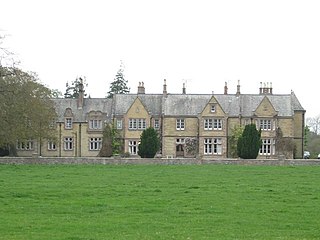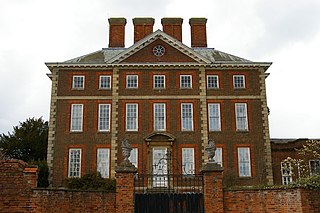
The Queen Anne style of British architecture refers to either the English Baroque architecture of the time of Queen Anne or the British Queen Anne Revival form that became popular during the last quarter of the 19th century and the early decades of the 20th century. In other English-speaking parts of the world, New World Queen Anne Revival architecture embodies entirely different styles.

Government House of British Columbia is the official residence of the lieutenant governor of British Columbia, as well as that in Victoria of the Canadian monarch, and has casually been described as "the Ceremonial Home of all British Columbians." It stands in the provincial capital on a 14.6 hectares estate at 1401 Rockland Avenue; while the equivalent building in many countries has a prominent, central place in the capital, the site of British Columbia's Government House is relatively unobtrusive within Victoria, giving it more the character of a private home.
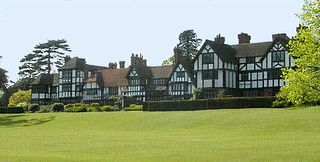
Tudor Revival architecture, also known as mock Tudor in the UK, first manifested in domestic architecture in the United Kingdom in the latter half of the 19th century. Based on revival of aspects that were perceived as Tudor architecture, in reality it usually took the style of English vernacular architecture of the Middle Ages that had survived into the Tudor period. The style later became an influence elsewhere, especially the British colonies. For example, in New Zealand, the architect Francis Petre adapted the style for the local climate. In Singapore, then a British colony, architects such as Regent Alfred John Bidwell pioneered what became known as the Black and White House. The earliest examples of the style originate with the works of such eminent architects as Norman Shaw and George Devey, in what at the time was considered Neo-Tudor design.
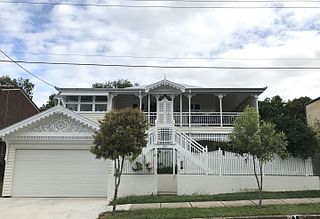
Australian residential architectural styles have evolved significantly over time, from the early days of structures made from relatively cheap and imported corrugated iron to more sophisticated styles borrowed from other countries, such as the California bungalow from the United States, the Georgian style from Europe and Northern America, and the Victorian style from the United Kingdom. A common feature of the Australian home is the use of fencing in front gardens, also common in both the United Kingdom and the United States.
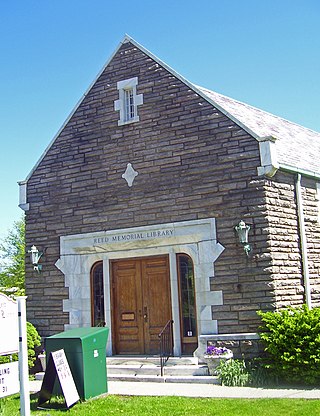
Reed Memorial Library is located at the junction of US 6 and NY 52 in Carmel, New York, United States. It is the oldest library building in Putnam County, and was listed on the National Register of Historic Places in 1980.
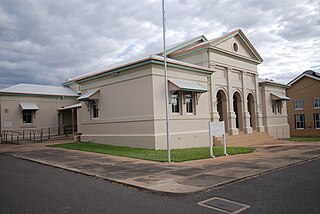
Charters Towers Courthouse is a heritage-listed courthouse at 28 Hodgkinson Street, Charters Towers City, Charters Towers, Charters Towers Region, Queensland, Australia. It was designed by John James Clark and built in 1886 by Charles Miller. It is also known as Charters Towers Courthouse. It was added to the Queensland Heritage Register on 21 October 1992.
Samuel Maclure was a Canadian architect in British Columbia, Canada, from 1890 to 1920. He was born on 11 April 1860 in Sapperton, New Westminster, British Columbia, to John and Martha Maclure. He studied painting at the Spring Garden Institute in Philadelphia from 1884 to 1885, and he was a self-taught architect. He married Margaret Catherine (Daisy) Simpson, an accomplished pianist and portrait painter, on 10 August 1889.

Toowoomba Post Office is a heritage-listed former post office at 136 Margaret Street, Toowoomba City, Toowoomba, Toowoomba Region, Queensland, Australia. It was designed by Francis Drummond Greville Stanley and built from 1878 to 1908 by John Gargett. It was added to the Queensland Heritage Register on 24 January 2003.
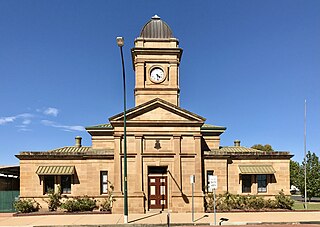
Warwick Court House and Police Complex is a heritage-listed courthouse at 88 Fitzroy Street, Warwick, Southern Downs Region, Queensland, Australia. It was designed by John James Clark and built from 1885 to 1914 by William G Conley. It was added to the Queensland Heritage Register on 21 October 1992.

Gympie Lands Office is a heritage-listed former court house and public administration building at 26 Channon Street, Gympie, Queensland, Australia. It was designed by Queensland Department of Public Works and Queensland Colonial Architect's Office and built in 1942 by the Department of Public Works, Gympie City Council, Mark Doggett, Andrew Collins, and George Caldwell. It was added to the Queensland Heritage Register on 15 July 2011.

In the New World, Queen Anne Revival was a historicist architectural style of the late 19th and early 20th centuries. It was popular in the United States, Canada, Australia, and other countries. In Australia, it is also called Federation architecture.

The Wellington Post Office is a heritage-listed post office located at 21 Maughan Street, Wellington in the Dubbo Regional Council local government area of New South Wales, Australia. It was designed by Colonial Architect’s Office, under the direction of James Barnet, and built between 1869 and 1904. The property, which is owned by Australia Post, was added to the New South Wales State Heritage Register on 22 December 2000.
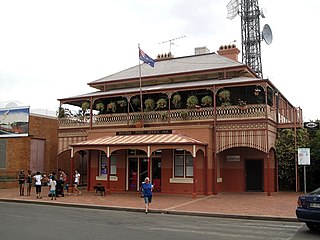
Bourke Post Office is a heritage-listed post office at 47 Oxley Street, Bourke, Bourke Shire, New South Wales, Australia. It was designed by the Colonial Architect's Office under James Barnet and built in 1880 by E. Heseler. It is also known as Bourke Post and Telegraph Office. The property is owned by the Keane Family Trust. It was added to the New South Wales State Heritage Register on 23 June 2000.

Broken Hill Post Office is a heritage-listed post office at 258-260 Argent Street, Broken Hill, City of Broken Hill, New South Wales, Australia. The original building was designed by James Barnet, and was built from 1890 to 1892 by John Dobbie. Walter Liberty Vernon designed a telegraph office addition in 1900. The property is owned by Australia Post. It was added to the New South Wales State Heritage Register on 22 December 2000. It was added to the Australian Commonwealth Heritage List on 08 November 2011.
Casino Post Office is a heritage-listed post office at 102 Barker Street, Casino, Richmond Valley Council, New South Wales, Australia. It was designed by the NSW Colonial Architect's Office and built from 1879. The property is owned by Australia Post. It was added to the New South Wales State Heritage Register on 23 June 2000.
Muswellbrook Post Office is a heritage-listed post office at 7 Bridge Street, Muswellbrook, New South Wales, Australia. It was added to the Australian Commonwealth Heritage List on 08 November 2011.

Charters Towers Post Office is a heritage-listed post office at 17 Gill Street, Charters Towers City, Charters Towers, Charters Towers Region, Queensland, Australia. It was added to the Australian Commonwealth Heritage List on 8 November 2011.
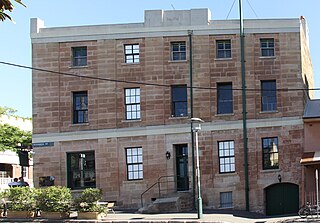
The Shipwrights Arms Inn is a heritage-listed residence and former inn and boarding house located at 75 Windmill Street, in the inner city Sydney suburb of Millers Point in the City of Sydney local government area of New South Wales, Australia. It was built from 1832 to 1834. It was added to the New South Wales State Heritage Register on 2 April 1999.

Clydebank is a heritage-listed residence at 43 Lower Fort Street, in the inner city Sydney suburb of Millers Point in the City of Sydney local government area of New South Wales, Australia. It was built from 1824 to 1825 by Robert Crawford. It is also known as Bligh House, Holbeck and St Elmo. It has also served as an art gallery and as offices in the past. It was added to the New South Wales State Heritage Register on 2 April 1999.





















